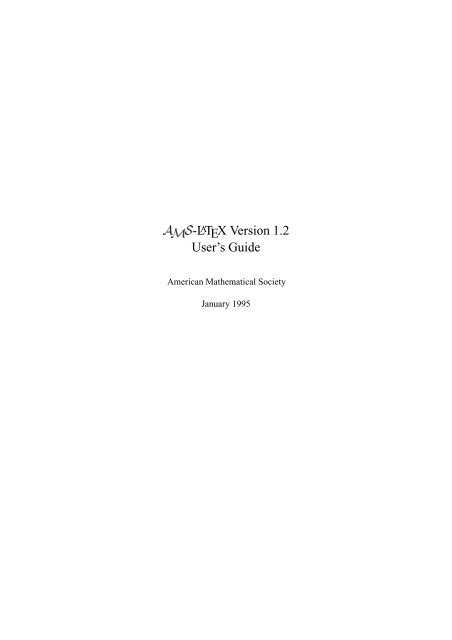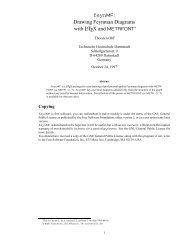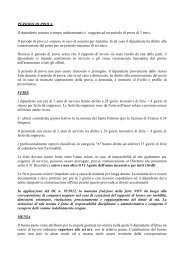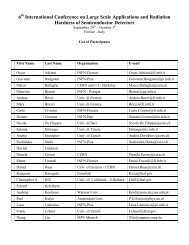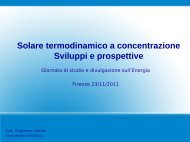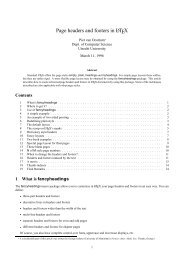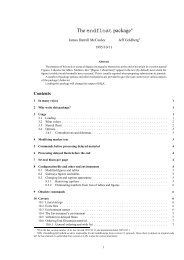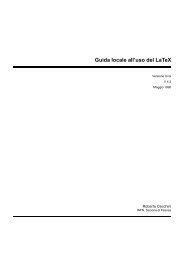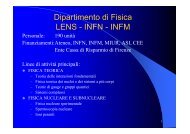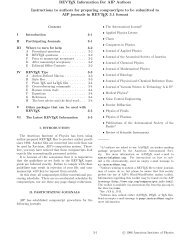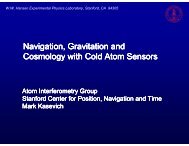AMS-LATEX Version 1.2 User's Guide - INFN
AMS-LATEX Version 1.2 User's Guide - INFN
AMS-LATEX Version 1.2 User's Guide - INFN
You also want an ePaper? Increase the reach of your titles
YUMPU automatically turns print PDFs into web optimized ePapers that Google loves.
<strong>AMS</strong>-L A TEX <strong>Version</strong> <strong>1.2</strong>User’s <strong>Guide</strong>American Mathematical SocietyJanuary 1995
iiCONTENTSContentsWhat is ‘<strong>AMS</strong>-<strong>LATEX</strong>’, and why would anyone want to use it?What is ‘<strong>AMS</strong>-<strong>LATEX</strong>’?.................................................Why would a <strong>LATEX</strong> user want to bother with <strong>AMS</strong>-<strong>LATEX</strong>? ..............................iviviv1 Howtouse<strong>AMS</strong>-<strong>LATEX</strong> 11.1 Using an <strong>AMS</strong> package in a <strong>LATEX</strong>document .................................. 1<strong>1.2</strong> Options for the amsmath package........................................ 12 Displayed equations (amsmath package) 22.1 Introduction . ................................................... 22.2 Singleequations.................................................. 22.3 Split equations without alignment ........................................ 22.4 Splitequationswithalignment .......................................... 22.5 Equation groups without alignment ........................................ 32.6 Equation groups with mutual alignment . .................................... 32.7 Alignmentbuildingblocks ............................................ 42.8 Adjusting tag placement . ............................................ 42.9 Vertical spacing and page breaks in multiline displays . ............................. 42.10Textualinterjectionswithinadisplay....................................... 52.11Equationnumbering................................................ 53 Miscellaneous mathematics features (amsmath package) 53.1 Matrices...................................................... 63.2 Mathspacingcommands ............................................. 63.3 Over and under arrows . . ............................................ 63.4 Dots........................................................ 73.5 Nonbreaking dashes ................................................ 73.6 Accents in math .................................................. 73.7 Roots ....................................................... 73.8 Boxedformulas.................................................. 83.9 Extensiblearrows................................................. 83.10Affixingsymbolstoothersymbols........................................ 83.11Fractionsandrelatedconstructions........................................ 83.12Continuedfractions................................................ 93.13Smashoptions................................................... 93.14Delimiters..................................................... 94 Operator names (amsopn, amsmath packages) 104.1 Definingnewoperatornames........................................... 104.2 \mod anditsrelatives............................................... 115 The\text command (amstext, amsmath packages) 116 The\boldsymbol command (amsbsy, amsmath packages) 117 Integrals and sums (amsmath, amsintx packages) 117.1 Multiple integral signs . . ............................................ 117.2 Multiline subscripts and superscripts . . . .................................... 127.3 The \sideset command ............................................ 127.4 The amsintx package.............................................. 128 Commutative diagrams (amscd package) 129 Using math fonts 139.1 Introduction . ................................................... 139.2 Recommendeduseofmathfontcommands ................................... 13
CONTENTSiii10 Theorems and related structures (amsthm package) 1310.1 Introduction . ................................................... 1410.2 The \newtheorem command.......................................... 1410.3Numberingmodifications............................................. 1410.4Changingstylesfortheorem-likeenvironments ................................. 1510.5Proofs....................................................... 15A Error messages and output problems 18A.1 Generalremarks.................................................. 18A.2 Errormessages .................................................. 18A.3 Wrongoutput................................................... 21B Other useful items for mathematical documents 22B.1 <strong>AMS</strong> documentclasses (amsart, amsbook, amsproc) ............................ 22B.2 Extramathfonts(the<strong>AMS</strong>Fontscollection)................................... 22B.3 Syntax checking (the syntonly package) ................................... 22B.4 Verbatim and comments (the verbatim package) ............................... 22B.5 Commutative diagrams and other diagrams (packages diagram, xypic, pstricks) ............ 22C Where to find other information 22C.1 Technicalnotes .................................................. 23C.2 Differences between <strong>AMS</strong>-<strong>LATEX</strong> version 1.1 and <strong>AMS</strong>-<strong>LATEX</strong> version<strong>1.2</strong>................... 23D Getting help 23D.1 Furtherinformation................................................ 23Bibliography 24Index 25
ivWHAT IS ‘<strong>AMS</strong>-<strong>LATEX</strong>’?What is ‘<strong>AMS</strong>-<strong>LATEX</strong>’, and why would anyone want to use it?What is ‘<strong>AMS</strong>-<strong>LATEX</strong>’?The name <strong>AMS</strong>-<strong>LATEX</strong> is used for convenience to describe a set of loosely related files that are distributed together bythe American Mathematical Society. Basically they may be described as miscellaneous enhancements to <strong>LATEX</strong> forsuperiorinformation structure of mathematical documents and superior printed output. Because <strong>AMS</strong>-<strong>LATEX</strong> is an extension for<strong>LATEX</strong>, which in turn is a ‘macro package’ for the TEX typesetting program, it follows that in order to use any of the pieces of<strong>AMS</strong>-<strong>LATEX</strong> you need to have TEXand<strong>LATEX</strong> installed first.<strong>LATEX</strong> by itself does a rather good job of typesetting mathematics, compared to non-TEX-based software; it doesn’t addmuch, however, to the basic set of mathematical capabilities that it adopted from the Plain TEX macro package.At the same time that <strong>LATEX</strong> was being developed by Leslie Lamport (roughly 1982–1986), the American MathematicalSociety was throwing its resources into the development of a different macro package known as <strong>AMS</strong>-TEX, written byMichael Spivak. By 1987 or so it became evident that <strong>AMS</strong>-TEX and<strong>LATEX</strong> had complementary feature sets: <strong>AMS</strong>-TEXfocused on the typesetting of math formulas and on fine-tuning typically done by publishers, and was relatively weak in otherareas (for example no automatic numbering or cross-reference facilities); <strong>LATEX</strong> focused on document structure and logicalmarkup of text, and had a comparatively limited set of features for dealing with math formula contents. This situation ledto dissatisfaction among both <strong>AMS</strong>-TEX and<strong>LATEX</strong> users who saw desirable features tantalizingly out of reach in the othermacro package. So the American Mathematical Society looked into the question of producing some sort of combinationof the two macro packages that would better serve mathematicians in their writing tasks. The decision that was eventuallytaken was to graft the mathematical capabilities of <strong>AMS</strong>-TEX onto the base stock of <strong>LATEX</strong> through an extension package:<strong>AMS</strong>-<strong>LATEX</strong>. Most of the programming work was done by Frank Mittelbach and Rainer Schöpf in 1989–1990 and version1.0 of <strong>AMS</strong>-<strong>LATEX</strong> was released in mid-1990.Whywoulda<strong>LATEX</strong> user want to bother with <strong>AMS</strong>-<strong>LATEX</strong>?If you are just starting out as a <strong>LATEX</strong> user, you’ll probably have to take our word for this (or the word of friends andcolleagues), but:If your writing contains a significant proportion of mathematics, and you care about the quality of the printed results, thensooner or later you’ll find shortcomings in standard <strong>LATEX</strong> and want to remedy them. Chances are that at least the first fewof the shortcomings you encounter will be ones that are already addressed by an <strong>AMS</strong>-<strong>LATEX</strong> package. If you want to havemaximum mathematical typesetting power ready at hand, rather than stop to cast about for a solution whenever you run intosome unusual demand in your writing, then <strong>AMS</strong>-<strong>LATEX</strong> will go a long way toward meeting your needs.If you are a long-time <strong>LATEX</strong> user and have lots of mathematics in what you write, then you may recognize solutions forsome familiar problems in this list of <strong>AMS</strong>-<strong>LATEX</strong> features: A convenient way to define new ‘operator name’ commands analogous to \sin and \lim, including proper sidespacing and automatic selection of the correct font style and size (even when used in sub- or superscripts). Multiple substitutes for the eqnarray environment to make various kinds of equation arrangements easier to write. Equation numbers automatically adjust up or down to avoid overprinting on the equation contents (unlike eqnarray). Spacing around equals signs matches the normal spacing in the equation environment (unlike eqnarray). A way to produce multiline subscripts as are often used with summation or product symbols. An easy way to substitute a variant equation number for a given equation instead of the automatically supplied number. An easy way to produce subordinate equation numbers of the form (1.3a) (1.3b) (1.3c) for selected groups of equations. A \boldsymbol command for printing bold versions of individual symbols, including things like ∞ and lowercaseGreek letters. An amsthm package that provides a useful proof environment and some enhancements to the \newtheoremcommand: support for multiple theorem styles in a single document and for unnumbered theorem types.
1. HOW TO USE <strong>AMS</strong>-<strong>LATEX</strong> 1—1—How to use <strong>AMS</strong>-<strong>LATEX</strong>1.1 Using an <strong>AMS</strong> package in a <strong>LATEX</strong> documentA ‘package’ in <strong>LATEX</strong> terminology is an extension written in such a form that it can be used via the \usepackage command.Many of the principal features of <strong>AMS</strong>-<strong>LATEX</strong> are provided in separate packages so that they can be used individually ondemand. The amsmath package is perhaps the single most noteworthy package, as it subsumes the amstext, amsbsy,and amsopn packages, and provides a number of other enhancements for mathematical typesetting. The current list ofpackages is:amsmath Defines extra environments for multiline displayed equations, as well as a number of other enhancements formath.amstext Provides a \text command for typesetting a fragment of text inside a display.amsbsy Defines \boldsymbol and \pmb ‘poor man’s bold’ commands.amsopn Provides \DeclareMathOperator for defining new ‘operator names’ like \sin and \lim.amsthm Provides a proof environment and extensions for the \newtheorem command.amsintx Provides more descriptive command syntax for integrals and sums.amscd Provides a CD environment for simple commutative diagrams (no support for diagonal arrows).amsxtra Provides certain odds and ends such as \fracwithdelims and \accentedsymbol.upref Makes \ref print cross-reference numbers always in an upright/roman font regardless of context.<strong>1.2</strong> Options for the amsmath packageThe amsmath package has the following options:centertags (default) For a split equation, place equation numbers vertically centered on the total height of the equation.tbtags ‘Top-or-bottom tags’: For a split equation, place equation numbers level with the last (resp. first) line, if numbersare on the right (resp. left).sumlimits (default) Place the subscripts and superscripts of summation symbols above and below, in displayed equations.This option also affects other symbols of the same type—∏, , N , L , and so forth—but excluding integrals (seebelow).nosumlimits Always place the subscripts and superscripts of summation-type symbols to the side, even in displayedequations.intlimits Like sumlimits, but for integral symbols.nointlimits (default) Opposite of intlimits.namelimits (default) Like sumlimits, but for certain ‘operator names’ such as det, inf, lim, max, min, that traditionallyhave subscripts placed underneath when they occur in a displayed equation.nonamelimits Opposite of namelimits.To use one of these package options, put the option name in the optional argument of the \usepackage command—e.g.,\usepackage[intlimits]{amsmath}.The amsmath package also recognizes the following options which are normally selected (implicitly or explicitly)through the \documentclass command, and thus need not be repeated in the option list of the \usepackage{amsmath}statement.leqno Place equation numbers on the left.reqno Place equation numbers on the right.fleqn Position equations at a fixed indent from the left margin rather than centered in the text column.
2. DISPLAYED EQUATIONS (<strong>AMS</strong>MATH PACKAGE) 3provides no numbering, because it is intended to be used only inside some other displayed equation structure, usually anequation, align,orgather environment, which provides the numbering. For example:H 1 nc =2n∑( 1) l (n l) p 2 p ni∑ ∏l=0l 1 ++l p =l i=1l i(2.11) [(n l) (n i l i )] n i l i h(n l) 2 p∑j=1(n i l i ) 2 i:\begin{equation}\label{e:barwq}\begin{split}H_c&=\frac{1}{2n} \sumˆn_{l=0}(-1)ˆ{l}(n-{l})ˆ{p-2}\sum_{l _1+\dots+ l _p=l}\prodˆp_{i=1} \binom{n_i}{l _i}\\&\quad\cdot[(n-l )-(n_i-l _i)]ˆ{n_i-l _i}\cdot\Bigl[(n-l )ˆ2-\sumˆp_{j=1}(n_i-l _i)ˆ2\Bigr].\end{split}\end{equation}2.5 Equation groups without alignmentThe gather environment is used for a group of consecutive equations when there is no alignment desired among them; eachone is centered separately within the text width (see Table 2.1).2.6 Equation groups with mutual alignmentThe align environment is used for two or more equations when vertical alignment is desired; usually binary relations suchas equal signs are aligned (see Table 2.1).To have several equation columns side-by-side, use extra ampersands to separate the columns:(2.12)(2.13)(2.14)x = y X =Y a =b+cx 0 = y 0 X 0 = Y 0 a 0 = bx + x 0 = y + y 0 X + X 0 = Y +Y 0 a 0 b = c 0 b\begin{align}x&=y & X&=Y & a&=b+c\\x’&=y’ & X’&=Y’ & a’&=b\\x+x’&=y+y’ & X+X’&=Y+Y’ & a’b&=c’b\end{align}Line-by-line annotations on an equation can be done by judicious application of \text inside an align environment:(2.15)(2.16)(2.17)x = y 1 y 2 + y 3 y 5 + y 8 ::: by (2.21)= y 0 y by (3.1)= y(0)y 0 by Axiom 1.\begin{align}x& = y_1-y_2+y_3-y_5+y_8-\dots&& \text{by \eqref{eq:C}}\\& = y’\circ yˆ* && \text{by \eqref{eq:D}}\\& = y(0) y’ && \text {by Axiom 1.}\end{align}A variant environment alignat allows the space between equation columns to be explicitly specified. Here the number ofequation columns must also be specified (where the number of ‘columns’ is calculated as (1+& max )=2 with & max = maximumnumber of & markers on any line).(2.18)(2.19)(2.20)x = y 1 y 2 + y 3 y 5 + y 8 ::: by (2.21)= y 0 y by (3.1)= y(0)y 0 by Axiom 1.\begin{alignat}{2}x& = y_1-y_2+y_3-y_5+y_8-\dots&\quad& \text{by \eqref{eq:C}}\\& = y’\circ yˆ* && \text{by \eqref{eq:D}}\\& = y(0) y’ && \text {by Axiom 1.}\end{alignat}
4 2. DISPLAYED EQUATIONS (<strong>AMS</strong>MATH PACKAGE)2.7 Alignment building blocksSome other equation alignment environments, such as aligned and gathered, construct self-contained units that can beused inside of other expressions, or set side-by-side. These environments take an optional argument to specify their verticalpositioning with respect to the material on either side. The default is ‘middle’ placement with the vertical midpoint of thetotal unit falling on the math axis 2 . For example:α = ααβ = βββββγ = γ\begin{equation*}\begin{aligned}\alpha&=\alpha\alpha\\\beta&=\beta\beta\beta\beta\beta\\\gamma&=\gamma\end{aligned}\qquad\text{versus}\qquad\begin{aligned}[t]\delta&=\delta\delta\\\eta&=\eta\eta\eta\eta\eta\eta\\\varphi&=\varphi\end{aligned}\end{equation*}versus“Cases” constructions like the following are common in mathematics:δ = δδη = ηηηηηηϕ = ϕ(2.21)P r j =(0 ifr j is odd;r! ( 1) (r j)=2 if r j is even:andintheamsmath package there is a cases environment to make them easy to write:P_{r-j}=\begin{cases}0& \text{if $r-j$ is odd},\\r!\,(-1)ˆ{(r-j)/2}& \text{if $r-j$ is even}.\end{cases}Notice the use of \text and the embedded math.2.8 Adjusting tag placementPlacing equation numbers can be a rather complex problem in multiline displays. The environments of the amsmath packagetry hard to avoid overprinting an equation number on the equation contents, if necessary moving the number down or up toa separate line. Even so, difficulties in accurately calculating the profile of an equation can occasionally result in a numberplacement that doesn’t look right. So there is a \raisetag command provided to adjust the vertical position of the currentequation number. To move a particular number up by six points, write \raisetag{6pt}. (This kind of adjustment is finetuning like line breaks and page breaks, and should therefore be left undone until your document is nearly finalized, or youmay end up redoing the fine tuning several times to keep up with changing document contents.)2.9 Vertical spacing and page breaks in multiline displaysYou can use the \\[hdimensioni] command to get extra vertical space between lines in all the amsmath displayed equationenvironments, as is usual in <strong>LATEX</strong>. Unlike eqnarray, theamsmath environments don’t allow page breaks between lines,unless \displaybreak or allowdisplaybreaks is used. The philosophy is that page breaks in such situations shouldreceive individual attention from the author. \displaybreak is best placed immediately before the \\ where it is totake effect. Like <strong>LATEX</strong>’s \pagebreak, \displaybreak takes an optional argument between 0 and 4 denoting thedesirability of the pagebreak. \displaybreak[0] means “it is permissible to break here” without encouraging a break;\displaybreak with no optional argument is the same as \displaybreak[4] and forces a break.If you prefer a strategy of letting page breaks fall where they may, even in the middle of a multi-line equation, then youmight put \allowdisplaybreaks in the preamble of your document. An optional argument 1–4 can be used for finercontrol: [1] means allow page breaks, but avoid them as much as possible; values of 2,3,4 mean increasing permissiveness.When display breaks are enabled with \allowdisplaybreaks,the\\* command can be used to prohibit a pagebreakafter a given line, as usual.2 The height of the cross-bar in the + symbol.
3. MISCELLANEOUS MATHEMATICS FEATURES 9To illustrate, here is how \frac, \tfrac,and\binom might be defined.\newcommand{\frac}[2]{\genfrac{}{}{}{}{#1}{#2}}\newcommand{\tfrac}[2]{\genfrac{}{}{}{1}{#1}{#2}}\newcommand{\binom}[2]{\genfrac{(}{)}{0pt}{}{#1}{#2}}If you find yourself repeatedly using \genfrac throughout a document for a particular notation, you will do yourself afavor (and your publisher) if you define a meaningfully-named abbreviation for that notation, along the lines of \frac and\binom.3.12 Continued fractionsThe continued fraction(3.6)1p2 +1p2 +1p2 +can be obtained by typing\cfrac{1}{\sqrt{2}+\cfrac{1}{\sqrt{2}+\cfrac{1}{\sqrt{2}+\dotsb}}}This produces better-looking results than straightforward use of \frac. Left or right placement of any of the numeratorsis accomplished by using \cfrac[l] or \cfrac[r] instead of \cfrac.3.13 Smash optionsThe command \smash is used to typeset a subformula and give it an effective height and depth of zero, which is sometimesuseful in adjusting the subformula’s position with respect to adjacent symbols. With the amsmath package \smash hasoptional arguments t and b, because occasionally it is advantageous to be able to “smash” only the top or only the bottomof something while retaining the natural depth or height. For example, when adjacent radical symbols are unevenly sizedor positioned because of differences in the height and depth of their contents, \smash can be employed to make themmore consistent. Compare p x + p y + p z and p x + p y + p z, where the latter was produced by $\sqrt{x} + \sqrt{\smash[b]{y}} + \sqrt{z}$.3.14 Delimiters3.14.1 Delimiter sizesA subject that escapes mention in the <strong>LATEX</strong> book is how to control the size of large delimiters if the automatic sizingdone by \left and \right produces unsatisfactory results. The automatic sizing has two limitations: First, it is appliedmechanically to produce delimiters large enough to encompass the largest contained item, and second, the range of sizes is noteven approximately continuous but has fairly large quantum jumps. This means that a math fragment that is infinitesimallytoo large for a given delimiter size will get the next larger size, a jump of 3pt or so in normal-sized text. There are two orthree situations where the delimiter size is commonly adjusted, using a set of commands that have ‘big’ in their names.Delimiter text \left \bigl \Bigl \biggl \Bigglsize size \right \bigr \Bigr \biggr \BiggrResult c (b)(d d c c c!c) (b) bbdb!dd b cdThe first kind of situation is a cumulative operator with limits above and below. With \left and \right the delimitersusually turn out larger than necessary, and using the Big or bigg sizes instead gives better results:"∑ia i ∑ jx ij p # 1=pversus∑ia i∑ xjij p 1=p\biggl[\sum_i a_i\Bigl\lvert\sum_j x_{ij}\Bigr\rvertˆp\biggr]ˆ{1/p}The second kind of situation is clustered pairs of delimiters where \left and \right make them all the same size (becausethat is adequate to cover the encompassed material) but what you really want is to make some of the delimiters slightly largerto make the nesting easier to see.((a 1 b 1 ) (a 2 b 2 )) ((a 2 b 1 )+(a 1 b 2 )) versus (a 1 b 1 ) (a 2 b 2 )(a 2 b 1 )+(a 1 b 2 )
10 4. OPERATOR NAMES (<strong>AMS</strong>OPN, <strong>AMS</strong>MATH PACKAGES)\left((a_1 b_1) - (a_2 b_2)\right)\left((a_2 b_1) + (a_1 b_2)\right)\quad\text{versus}\quad\bigl((a_1 b_1) - (a_2 b_2)\bigr)\bigl((a_2 b_1) + (a_1 b_2)\bigr) where the delimiters produced by \leftThe third kind of situation is a slightly oversize object in running text, such as b0d 0and \right cause too much line spreading. In that case \bigl and \bigr can be used to produce delimiters that arebslightly larger than the base size but still able to fit within the normal line spacing: 0 0d .In ordinary <strong>LATEX</strong> \big, \bigg, \Big, and\Bigg delimiters aren’t scaled properly over the full range of <strong>LATEX</strong> fontsizes. With the amsmath package they are.3.14.2 Vertical bar notationsThe amsmath package provides commands \lvert, \rvert, \lVert, \rVert (compare \langle, \rangle) toaddress the problem of overloading for the vert bar character |. This character is currently used in <strong>LATEX</strong> documents torepresent a wide variety of mathematical objects: the ‘divides’ relation in a number-theory expression like pjq, or the absolutevalueoperation jzj, or the ‘such that’ condition in set notation, or the ‘evaluated at’ notation f ζ (t)t=0. The multiplicity of usesin itself is not so bad; what is bad, however, is that fact that not all of the uses take the same typographical treatment, and thatthe complex discriminatory powers of a knowledgeable reader cannot be replicated in computer processing of mathematicaldocuments, at least not without a significant cost in processing speed, and even then not without falling somewhat shortof human readers’ abilities. It is recommended therefore that there should be a one-to-one correspondence in any givendocument between the vert bar character | and a selected mathematical notation, and similarly for the double-bar command\|. This immediately rules out the use of | and \| for delimiters, as in the notations for absolute value or norm, becauseleft and right delimiters are distinct usages that do not relate in the same way to adjacent symbols; recommended practice istherefore to define suitable commands in the document preamble for any paired-delimiter use of vert bar symbols:\newcommand{\abs}[1]{\lvert#1\rvert}\newcommand{\norm}[1]{\lVert#1\rVert}whereupon the document would contain \abs{z} to produce jzj and \norm{v} to produce kvk.—4—Operator names (amsopn, amsmath packages)4.1 Defining new operator namesMath functions such as log, sin, and lim are traditionally typeset in roman type to make them visually more distinct from onelettermath variables, which are set in math italic. The more common ones have predefined names, \log, \sin, \lim,andso forth, but new ones come up all the time in mathematical papers, so the amsopn package provides a general mechanismfor defining new ‘operator names’. As the amsopn package is loaded internally by the amsmath package, the followingfeatures are available there also. To define a math function \xxx to work like \sin, you write\DeclareMathOperator{\xxx}{xxx}whereupon ensuing uses of \xxx will produce xxx in the proper font and automatically add proper spacing on either sidewhen necessary, so that you get AxxxB instead of AxxxB. In the second argument of \DeclareMathOperator (the nametext), a pseudo-text mode prevails: the hyphen character - will print as a text hyphen rather than a minus sign and an asterisk* will print as a raised text asterisk instead of a centered math star. (Compare a-b*c and a b c.) But otherwise the nametext is printed in math mode, so that you can use, e.g., subscripts and superscripts there.If the new operator should have subscripts and superscripts placed in ‘limits’ position above and below as with lim, sup,or max, use the * form of the \DeclareMathOperator command:\DeclareMathOperator*{\Lim}{Lim}A few special operator names are predefined by the amsopn package: \varinjlim, \varprojlim, \varliminf,and \varlimsup:\varlimsup lim n!∞ Q (u n ;u n u) 0\varliminf lim n!∞ ja n+1 j=ja n j = 0\varinjlim lim ! (mλ i ) 0\varprojlim lim p2S(A) A p 0
7. INTEGRALS AND SUMS (<strong>AMS</strong>MATH, <strong>AMS</strong>INTX PACKAGES) 114.2 \mod and its relativesCommands \mod, \bmod, \pmod, \pod are provided by the amsopn package to deal with the special spacing conventionsof “mod” notation. \bmod and \pmod areavailablein<strong>LATEX</strong>, but with the amsopn package the spacing of \pmod willadjust to a smaller value if it’s used in a non-display-mode formula. \mod and \pod are variants of \pmod preferred bysome authors; \mod omits the parentheses, whereas \pod omits the “mod” and retains the parentheses.(4.1)gcd(n;m mod n); x y (mod b); x y mod c; x y (d)\gcd(n,m\bmod n);\quad x\equiv y\pmod b;\quad x\equiv y\mod c;\quad x\equiv y\pod d—5—The \text command (amstext, amsmath packages)The \text command is defined by the amsmath package through a subordinate package amstext (which can also beused independently if desired). The main use of the command \text is for words or phrases in a display. It is verysimilar to the <strong>LATEX</strong> command \mbox in its effects, but has a couple of advantages. If you want a word or phrase of textin a subscript, you can type ..._{\text{word or phrase}}, which is slightly easier than the \mbox equivalent:..._{\mbox{\scriptsize word or phrase}}. The other advantage is the more descriptive name.(5.1)f [xi 1 ;x i ] is monotonic, i = 1;:::;c+1f_{[x_{i-1},x_i]} \text{ is monotonic,}\quad i = 1,\dots,c+1—6—The \boldsymbol command (amsbsy, amsmath packages)The \boldsymbol and \pmb commands are defined by the amsbsy package (also loaded by amsmath). The \boldsymbolcommand is used to obtain bold numbers and other nonalphabetic symbols, as well as bold Greek letters, which cannot bemade bold via the \mathbf command. 1 It can also be used to obtain bold math italic letters; compare the results of M,\mathbf{M} and \boldsymbol{M}: MMM.The availability of bold symbols varies on different systems depending on whether or not suitable fonts are installed. The\boldsymbol command should usually work fine for the common math symbols at 10pt size or larger, but if you find thatit is not having the desired effect for a particular symbol, you could either (a) verify that the necessary fonts are available andproperly installed; or (b) use \pmb: “poor man’s bold”, which works by printing multiple copies of the same symbol withslight offsets.(6.1)A ∞ + πA 0 A ∞ + πA 0 A ∞ + πA 0A_\infty + \pi A_0\sim \mathbf{A}_{\boldsymbol{\infty}} \boldsymbol{+}\boldsymbol{\pi} \mathbf{A}_{\boldsymbol{0}}\sim\pmb{A}_{\pmb{\infty}} \pmb{+}\pmb{\pi} \pmb{A}_{\pmb{0}}—7—Integrals and sums (amsmath, amsintx packages)7.1 Multiple integral signs\iint, \iiint,and\iiiint give multiple integral signs with the spacing between them nicely adjusted, in both text anddisplay style. \idotsint is an extension of the same idea that gives two integral signs with dots between them.1 Actually, depending on which font set you use, \mathbf may—inconsistently—work for cap Greek letters but not for lowercase.
12 8. COMMUTATIVE DIAGR<strong>AMS</strong> (<strong>AMS</strong>CD PACKAGE)7.2 Multiline subscripts and superscriptsThe \substack command can be used to produce a multiline subscript or superscript: for example\sum_{\substack{0\le i\le m\\ 0
10. THEOREMS AND RELATED STRUCTURES (<strong>AMS</strong>THM PACKAGE) 13\begin{CD}Sˆ{{\mathcal{W}}_\Lambda}\otimes T @>j>> T\\@VVV@VV{\End P}V\\(S\otimes T)/I @= (Z\otimes T)/J\end{CD}In the CD environment the commands @>>>, @
14 10. THEOREMS AND RELATED STRUCTURES—10—Theorems and related structures (amsthm package)10.1 IntroductionThe amsthm package provides an enhanced version of the <strong>LATEX</strong> command \newtheorem for defining theorem-like environments.The amsthm version of the \newtheorem command recognizes a \theoremstyle specification (as inMittelbach’s theorem package) and has a * form for defining unnumbered environments. The amsthm package also definesa proof environment that automatically adds a Q.E.D. symbol at the end. <strong>AMS</strong> document classes automatically loadthe amsthm package, so everything described here applies to them as well. An example file thmtest.tex is provided inthe <strong>AMS</strong>-<strong>LATEX</strong> distribution.10.2 The \newtheorem commandIn mathematical research articles and books, theorems and proofs are among the most common elements, but authors alsouse many others that fall in the same general class: lemmas, propositions, axioms, corollaries, conjectures, definitions,remarks,, cases, steps, and so forth. As these elements form a slice of the text stream with well-defined boundaries, they arenaturally handled in <strong>LATEX</strong> as environments. But <strong>LATEX</strong> document classes normally do not provide predefined environments fortheorem-like elements because (a) that would make it difficult for authors to exercise the necessary control over the automaticnumbering, and (b) the variety of such elements is so wide that it’s just not possible for a document class to provide every onethat will ever be needed. Instead there is a command \newtheorem, similar to \newenvironment in effect, that makesit easy for authors to set up the elements required for a particular document.The \newtheorem command has two mandatory arguments; the first one is the environment name that the author wouldlike to use for this element; the second one is the heading text. For example,\newtheorem{lem}{Lemma}means that instances in the document of\begin{lem} Text text ... \end{lem}will produceLemma 1. Text text :::where the heading consists of the specified text ‘Lemma’ and an automatically generated number and punctuation.If \newtheorem* is used instead of \newtheorem in the above example, there will not be any automatic numbersgenerated for any of the lemmas in the document. This form of the command can be useful if you have only one lemma anddon’t want it to be numbered; more often, though, it is used to produce a special named variant of one of the common theoremtypes. For example, if you have a lemma whose name should be ‘Klein’s Lemma’ instead of ‘Lemma’ + number, then thestatement\newtheorem*{KL}{Klein’s Lemma}would allow you to write\begin{KL} Text text ... \end{KL}and get the desired output.10.3 Numbering modificationsIn addition to the two mandatory arguments, \newtheorem has two mutually exclusive optional arguments. These affectthe sequencing and hierarchy of the numbering.By default each kind of theorem-like environment is numbered independently. Thus if you have three lemmas and twotheorems interspersed, they will be numbered something like this: Lemma 1, Lemma 2, Theorem 1, Lemma 3, Theorem2. If you want lemmas and theorems to share the same numbering sequence—Lemma 1, Lemma 2, Theorem 3, Lemma 4,Theorem 5—then you should indicate the desired relationship as follows:\newtheorem{thm}{Theorem}\newtheorem{lem}[thm]{Lemma}The optional argument [thm] in the second statement means that the lem environment should share the thm numberingsequence instead of having its own independent sequence.To have a theorem-like environment numbered subordinately within a sectional unit—e.g., to get propositions numberedProposition 2.1, Proposition 2.2, and so on in Section 2—put the name of the parent unit in square brackets in final position:\newtheorem{prop}{Proposition}[section]With the optional argument [section], theprop counter will be reset to 0 whenever the parent counter section isincremented.
10. THEOREMS AND RELATED STRUCTURES 1510.4 Changing styles for theorem-like environments10.4.1 The \theoremstyle commandThe amsthm package supports the notion of a current theorem style, which determines what will be produced by a given\newtheorem command. The three theorem styles provided—plain, definition, andremark—receive differenttypographical treatment that gives them visual emphasis corresponding to their relative importance. The details of thistypographical treatment may vary depending on the document class, but typically the plain style produces italic body text,while the other two styles produce roman body text.To create new theorem-like environments in the different styles, divide your \newtheorem commands into groups andpreface each group with the appropriate \theoremstyle. Ifno\theoremstyle command is given, the style used willbe plain. Some examples:\theoremstyle{plain}% default\newtheorem{thm}{Theorem}[section]\newtheorem{lem}[thm]{Lemma}\newtheorem{prop}[thm]{Proposition}\newtheorem*{cor}{Corollary}\newtheorem*{KL}{Klein’s Lemma}\theoremstyle{definition}\newtheorem{defn}{Definition}[section]\newtheorem{conj}{Conjecture}[section]\newtheorem{exmp}{Example}[section]\theoremstyle{remark}\newtheorem*{rem}{Remark}\newtheorem*{note}{Note}\newtheorem{case}{Case}10.4.2 Number swappingA not uncommon style variation for theorem heads is to have the theorem number on the left, at the beginning of the heading,instead of on the right. As this variation is usually applied across the board regardless of individual \theoremstylechanges, number-swapping is done by placing a \swapnumbers command at the beginning of the list of \newtheoremstatements that should be affected. For example:\swapnumbers\theoremstyle{plain}\newtheorem{thm}{Theorem}\theoremstyle{remark}\newtheorem{rem}{Remark}After the above declarations, theorem and remark heads will be printed in the form 1.4 Theorem., 9.1. Remark.10.4.3 Further customization possibilitiesMore extensive customization capabilities are provided by the amsthm package in the form of a \newtheoremstylecommand and a mechanism for using package options to load custom theoremstyle definitions. As these capabilities aresomewhat beyond the needs of the average user, discussion of the details is consigned to the example file thmtest.texand to the commentary in amsthm.dtx.10.5 ProofsApredefinedproof environment provided by the amsthm package produces the heading “Proof” with appropriate spacingand punctuation. The proof environment is primarily intended for short proofs, no more than a page or two in length; longerproofs are usually better done as a separate \section or \subsection in your document.A ‘Q.E.D.’ symbol, , is automatically appended at the end of a proof environment. To substitute a different end-ofproofsymbol, use \renewcommand to redefine the command \qedsymbol. For a long proof done as a subsection orsection instead of with the proof environment, you can obtain the symbol and the usual amount of preceding space by using\qed.Placement of the Q.E.D. symbol can be problematic if the last part of a proof environment is a displayed equation or listenvironment or something of that nature. Adequate results can sometimes be obtained by using \qed at the appropriate spotand then undefining \qed just before the end of the proof. (The effect will be automatically localized to the current proof bynormal <strong>LATEX</strong> scoping rules.) For example:
16 10. THEOREMS AND RELATED STRUCTURES\begin{proof}...\begin{equation}G(t)=L\gamma!\,tˆ{-\gamma}+tˆ{-\delta}\eta(t) \qed\end{equation}\renewcommand{\qed}{}\end{proof}An optional argument of the proof environment allows you to substitute a different name for the standard “Proof”. If youwant the proof heading to be, say, “Proof of the Main Theorem”, then write\begin{proof}[Proof of the Main Theorem]
10. THEOREMS AND RELATED STRUCTURES 17Table 2.1. Comparison of displayed equation environments (vertical lines indicating nominal margins)\begin{equation*}a=b\end{equation*}\begin{equation}a=b\end{equation}\begin{equation}\label{xx}\begin{split}a& =b+c-d\\& \quad +e-f\\& =g+h\\& =i\end{split}\end{equation}\begin{multline}a+b+c+d+e+f\\+i+j+k+l+m+n\end{multline}\begin{gather}a_1=b_1+c_1\\a_2=b_2+c_2-d_2+e_2\end{gather}\begin{align}a_1& =b_1+c_1\\a_2& =b_2+c_2-d_2+e_2\end{align}\begin{align}a_{11}& =b_{11}&a_{12}& =b_{12}\\a_{21}& =b_{21}&a_{22}& =b_{22}+c_{22}\end{align}\begin{flalign*}a_{11}& =b_{11}&a_{12}& =b_{12}\\a_{21}& =b_{21}&a_{22}& =b_{22}+c_{22}\end{flalign*}a = b(1)a = ba = b + c d+ e f(2)= g + h= i(3) a + b + c + d + e + f+ i + j + k + l + m + n(4)a 1 = b 1 + c 1(5)a 2 = b 2 + c 2 d 2 + e 2(6)a 1 = b 1 + c 1(7)a 2 = b 2 + c 2 d 2 + e 2(8) a 11 = b 11 a 12 = b 12(9) a 21 = b 21 a 22 = b 22 + c 22a 11 = b 11 a 12 = b 12a 21 = b 21 a 22 = b 22 + c 22
18 Appendix A. ERROR MESSAGES AND OUTPUT PROBLEMS—Appendix A—Error messages and output problemsA.1 General remarksThis is a supplement to Chapter 8 of the <strong>LATEX</strong> manual [5] (first edition: Chapter 6). For the reader’s convenience, the setof error messages discussed here overlaps somewhat with the set in that chapter, but please be aware that we don’t provideexhaustive coverage here. The error messages are arranged in alphabetical order, disregarding unimportant text such as! LaTeX Error: at the beginning, and nonalphabetical characters such as \. Where examples are given, we show alsothe help messages that appear on screen when you respond to an error message prompt by entering h.There is also a section discussing some output errors, i.e., instances where the printed document has something wrong butthere was no <strong>LATEX</strong> error during typesetting.A.2 Error messages\begin{split} won’t work here.Example:! Package amsmath Error: \begin{split} won’t work here....l.8 \begin{split}? h\Did you forget a preceding \begin{equation}?If not, perhaps the ‘aligned’ environment is what you want.?Explanation:Thesplit environment does not construct a stand-alone displayed equation; it needs to be used within someother environment such as equation or gather.Extra & on this lineExample:! Package amsmath Error: Extra & on this line.See the amsmath package documentation for explanation.Type H for immediate help....l.9 \end{alignat}? h\An extra & here is so disastrous that you should probably exitand fix things up.?Explanation: Inanalignat structure the number of alignment points per line is dictated by the numeric argument givenafter \begin{alignat}. If you use more alignment points in a line it is assumed that you accidentally left out a newlinecommand \\ and the above error is issued.Font OMX/cmex/m/n/7=cmex7 not loadable ...Example:! Font OMX/cmex/m/n/7=cmex7 not loadable: Metric (TFM) file not found.relaxl.8 $ab+bˆ2$? hI wasn’t able to read the size data for this font,so I will ignore the font specification.[Wizards can fix TFM files using TFtoPL/PLtoTF.]
Appendix A. ERROR MESSAGES AND OUTPUT PROBLEMS 19You might try inserting a different font spec;e.g., type ‘I\font=’.?Explanation: Certain extra sizes of some Computer Modern fonts that were formerly available mainly through the <strong>AMS</strong>Fontsdistribution are considered part of standard <strong>LATEX</strong> (as of June 1994): cmex7–9, cmmib5–9, andcmbsy5–9. Iftheseextrasizes are missing on your system, you should try first to get them from the source where you obtained <strong>LATEX</strong>. If that fails, youcould try getting the fonts from CTAN (e.g., in the form of Metafont source files, directory /tex-archive/fonts/latex/mf,or in PostScript Type 1 format, directory /tex-archive/fonts/cm/ps-type1/bakoma).If the font name begins with cmex, there is a special option cmex10 for the amsmath package that provides a temporaryworkaround. I.e., change the \usepackage to\usepackage[cmex10]{amsmath}This will force the use of the 10-point size of the cmex font in all cases. Depending on the contents of your document thismay be adequate.Foreign command \over; use \frac or \genfrac insteadExample:! Package amsmath Error: Foreign command: \over; use \frac or \genfrac instead.See the amsmath package documentation for explanation.Type H for immediate help....l.49 Fractions ${1\over?2}$ andExplanation: The primitive generalized fraction commands of TEX aredisallowedbytheamsmath package because theirsyntax is foreign to <strong>LATEX</strong>. The substitutes \frac and \genfrac are provided instead. See x3.11.1 for further information.Math formula deleted: Insufficient extension fontsExample:! Math formula deleted: Insufficient extension fonts.l.8 $ab+bˆ2$?Explanation: This usually follows a previous error Font ... not loadable; see the discussion of that error (above)for solutions.Missing number, treated as zeroExample:! Missing number, treated as zero.al.100 \end{alignat}? hA number should have been here; I inserted ‘0’.(If you can’t figure out why I needed to see a number,look up ‘weird error’ in the index to The TeXbook.)?Explanation:There are many possibilities that can lead to this error. However, one possibilitythat is relevant for the amsmathis that you forgot to give the number argument of an alignat environment, as in:\begin{alignat}a& =b& c& =d\\a’& =b’& c’& =d’\end{alignat}
20 Appendix A. ERROR MESSAGES AND OUTPUT PROBLEMSwhere the first line should read instead\begin{alignat}{2}Another possibility is that you have a left bracket character [ following a linebreak command \\ in a multiline constructionsuch as array, tabular, oreqnarray. This will be interpreted by <strong>LATEX</strong> as the beginning of an ‘additional verticalspace’ request [5, xC.1.6], even if it occurs on the following line and is intended to be part of the contents. For example\begin{array}a+b\\[f,g]\\m+n\end{array}To prevent the error message in such a case, you can add braces as discussed in the <strong>LATEX</strong> manual [5, xC.1.1]:\begin{array}a+b\\{[f,g]}\\m+n\end{array}Missing \right. insertedExample:! Missing \right. inserted.\right .l.10 \end{multline}? hI’ve inserted something that you may have forgotten.(See the above.)With luck, this will get me unwedged. But if youreally didn’t forget anything, try typing ‘2’ now; thenmy insertion and my current dilemma will both disappear.Explanation: This error typically arises when you try to insert a linebreak inside a \left-\right pair of delimiters in amultline or split environment:\begin{multline}AAA\left(BBB\\CCC\right)\end{multline}There are two possible solutions: (1) instead of using \left and \right, use ‘big’ delimiters of fixed size (\bigl \bigr\biggl \biggr :::;seex3.14.1); or (2) use null delimiters to break up the \left-\right pair into parts for each line:AAA\left(BBB\right.\\\left.CCC\right)The latter solution may result in mismatched delimiter sizes; ensuring that they match requires using \vphantom in the linethat has the smaller delimiter (or possibly \smash in the line that has the larger delimiter). In the argument of \vphantomput a copy of the tallest element that occurs in the other line, e.g.,xxx \left(\int_t yyy\right.\\\left.\vphantom{\int_t} zzz ... \right)Paragraph ended before \xxx was completeExample:Runaway argument?! Paragraph ended before \equation was complete.\par
Appendix A. ERROR MESSAGES AND OUTPUT PROBLEMS 21l.100? hI suspect you’ve forgotten a ‘}’, causing me to apply thiscontrol sequence to too much text. How can we recover?My plan is to forget the whole thing and hope for the best.?Explanation: This might be produced by a misspelling in the \end{equation} command, e.g.,\begin{equation}...\end{equatin}or by using abbreviations such as \beq and \eeq for \begin{equation} and \end{equation}:\beq...\eeqThat kind of abbreviation works in ordinary <strong>LATEX</strong> but for technical reasons it does not work with any of the displayed equationenvironments (gather, align, split, equation, etc.) when the amsmath package is used. Work to re-enable the useof such abbreviations is under way, but nontrivial technical complications are involved (cf. technote.tex).Runaway argument?See the discussion for the error message Paragraph ended before \xxx was complete.Unknown option ‘xxx’ for package ‘yyy’Example:! LaTeX Error: Unknown option ‘intlim’ for package ‘amsmath’....? hThe option ‘intlim’ was not declared in package ‘amsmath’, perhaps youmisspelled its name. Try typing to proceed.?Explanation: This means that you misspelled the option name, or the package simply does not have an option that youexpected it to have. Consult the documentation for the given package.A.3 Wrong outputA.3.1 Section numbers 0.1, 5.1, 8.1 instead of 1, 2, 3This most likely means that you have the arguments for \numberwithin in reverse order:\numberwith{section}{equation}That means ‘print the section number as equation number.section number and reset to 1 every time an equation occurs’ whenwhat you probably wanted was the inverse\numberwith{equation}{section}A.3.2 The \numberwithin command had no effect on equation numbersAre you looking at the first section in your document? Check the section numbers elsewhere to see if the problem is the onedescribed in xA.3.1.A.3.3 Double accent command failed to position the second accent properlyThe capitalization of the command names is important. Check whether all of the accent commands are capitalized. Compare  Â\[\hat{\hat{A}}\quad\Hat{\hat{A}}\quad\Hat{\Hat{A}}\]
22 Appendix C. WHERE TO FIND OTHER INFORMATIONA.3.4 The \boldsymbol command didn’t workThis probably means that the font necessary to produce a bold version of the symbol in question is not available on yoursystem or not installed in a way that <strong>LATEX</strong> can use it. For example, bold versions of the <strong>AMS</strong> extra symbol fonts msam andmsbm do not currently exist, so \boldsymbol{\square} will merely produce the same result as \square alone.Also, the weight of the fonts cmmib and cmbsy is ‘bold’ rather than ‘bold extended’ as for cmbx. Depending on thesymbol in question and the resolution of your printer (or previewer), a symbol that was taken from one of those two boldsymbol fonts might be nearly indistinguishable from the non-bold version.—Appendix B—Other useful items for mathematical documentsB.1 <strong>AMS</strong> documentclasses (amsart, amsbook, amsproc)The American Mathematical Society provides custom <strong>AMS</strong>-<strong>LATEX</strong> document classes for <strong>AMS</strong> journals and book series.These may obtained by anonymous FTP from the e-MATH system e-math.ams.org, directory, in the author-infoarea. (Note that directory structures may occasionally change; if you have trouble locating files you need, please contact <strong>AMS</strong>Technical Support; see Appendix D.) Specific and generic classes can be requested by e-mail to ams-latex@math.ams.orgor ordered on floppy disk through the <strong>AMS</strong> Customer Services Department at cust-serv@math.ams.org or 800-321-4267.B.2 Extra math fonts (the <strong>AMS</strong>Fonts collection)The ‘<strong>AMS</strong>Fonts’ font collection is a set of extra math fonts that supplements the standard set of <strong>LATEX</strong> math fonts. It includes<strong>LATEX</strong> packages called amsfonts and amssymb that make it easy to use the extra fonts in a <strong>LATEX</strong> document. If you don’thave the <strong>AMS</strong>Fonts collection already on your system, and would like to use some of the symbols in it, it can be obtained byanonymous FTP from CTAN (see x??) or from the e-MATH system at e-math.ams.org. It can also be ordered on diskfrom the <strong>AMS</strong> Customer Services Department at cust-serv@math.ams.org or 800-321-4267.B.3 Syntax checking (the syntonly package)If you are working on a relatively slow computer system you might want to try the syntonly package. This makes <strong>LATEX</strong>skim through your document only checking for proper syntax and usage of the commands, but not producing any printedpages. As <strong>LATEX</strong> runs quite a bit faster under those conditions, for early error-checking runs of a document this can save youvaluable time. The syntonly package is a standard <strong>LATEX</strong> package so you should find it already on your system; to use it,write\usepackage{syntonly}\syntaxonlyWhen you want to produce pages, comment out the second line by adding a percent character:%\syntaxonlyB.4 Verbatim and comments (the verbatim package)The verbatim package is another standard <strong>LATEX</strong> package, like syntonly. In addition to some minor enhancements forthe verbatim environment, it provides a comment environment that skips everything between \begin{comment} andthe next \end{comment}. A command \verbatiminput is also provided for typesetting a whole file in verbatim style.B.5 Commutative diagrams and other diagrams (packages diagram, xypic, pstricks)The amscd package for commutative diagrams that is included in the <strong>AMS</strong>-<strong>LATEX</strong> distributionis quite limited. The followingpackages are worth investigation for authors who need more powerful diagram features: diagram, xypic, pstricks.These are available by anonymous FTP from CTAN (see x??). The diagram package, by Michael Barr, focuses on commutativediagrams and is thus smaller than the others; it uses <strong>LATEX</strong> arrows as produced by \vector for diagram construction.The xypic package, by Kristoffer Rose, is a more general diagram package; it requires special arrow fonts (included inthe xypic distribution) or PostScript capabilities in your system. The pstricks package, by Timothy van Zandt, alsoprovides general diagram object commands; it is strictly for PostScript use, as the name implies.
Appendix D. GETTING HELP 23—Appendix C—Where to find other informationC.1 Technical notesThe file technote.tex contains some remarks on miscellaneous technical questions related to <strong>AMS</strong>-<strong>LATEX</strong>; they arerelegated to a separate document because they are unlikely to be of interest to most users.C.2 Differences between <strong>AMS</strong>-<strong>LATEX</strong> version 1.1 and <strong>AMS</strong>-<strong>LATEX</strong> version <strong>1.2</strong><strong>Version</strong> <strong>1.2</strong> of <strong>AMS</strong>-<strong>LATEX</strong> fills in some gaps and corrects some mistakes in the <strong>AMS</strong>-<strong>LATEX</strong> 1.1 feature set. The significantdifferences, from a user’s perspective, are described in the document diff12.tex.—Appendix D—Getting helpQuestions or comments regarding the <strong>AMS</strong>-<strong>LATEX</strong> package should be sent to:American Mathematical SocietyTechnical SupportElectronic Products and ServicesP. O. Box 6248Providence, RI 02940Phone: 800-321-4<strong>AMS</strong> (321-4267) or 401-455-4080Internet: tech-support@math.ams.orgIf you are reporting a problem you should include the following information to make proper investigation possible:1. The source file where the problem occurred, preferably reduced to minimum size by removing any material that can beremoved without affecting the observed problem.2. A <strong>LATEX</strong> log file showing the error message (if applicable) and the version numbers of the document class and optionfiles being used.D.1 Further informationInformation about obtaining <strong>AMS</strong>Fonts or other TEX-related software from the <strong>AMS</strong> Internet archive e-math.ams.orgcan be obtained by sending a request through electronic mail to: e-math@math.ams.org.
24 BIBLIOGRAPHYInformation about obtaining <strong>AMS</strong>-<strong>LATEX</strong> on diskette from the <strong>AMS</strong> is available from:American Mathematical SocietyCustomer ServicesP. O. Box 6248Providence, RI 02940Phone: 800-321-4<strong>AMS</strong> (321-4267) or 401-455-4000Internet: cust-serv@math.ams.orgThe TEX Users Group is a nonprofit organization that publishes a journal (TUGboat), holds meetings, and serves as aclearing-house of general information about TEX andTEX-related software.TEX Users GroupP. O. Box 869Santa Barbara, CA 93102-0869Phone: (805) 963-1338Internet: tug@tug.orgMembership in the TEX Users Group is a good way to support continued development of free TEX-related software. Thereare also many local TEX user groups in other countries; information about contacting a local user group can be gotten fromthe TEX Users Group.There is a Usenet newsgroup called comp.text.tex that is a fairly good source of information about <strong>LATEX</strong> andTEXin general. If you don’t know about reading newsgroups, check with your local system administrator to see if newsgroupservice is available at your site.Bibliography[1] <strong>AMS</strong>Fonts version 2.2—user’s guide, Amer. Math. Soc., Providence, RI, 1994; distributed with the <strong>AMS</strong>Fonts package.[2] Instructions for preparation of papers and monographs—<strong>AMS</strong>-<strong>LATEX</strong>, Amer. Math. Soc., Providence, RI, 1994.[3] Michel Goossens, Frank Mittelbach, and Alexander Samarin, The <strong>LATEX</strong> companion, Addison-Wesley, Reading, MA,1994.[4] Donald E. Knuth, The TEXbook, Addison-Wesley, Reading, MA, 1984.[5] Leslie Lamport, <strong>LATEX</strong>: A document preparation system, 2nd revised ed., Addison-Wesley, Reading, MA, 1994.[6] Frank Mittelbach and Rainer Schöpf, The new font family selection—user interface to standard <strong>LATEX</strong>, TUGboat 11, no. 2(June 1990), pp. 297–305.[7] Michael Spivak, The joy of TEX, 2nd revised ed., Amer. Math. Soc., Providence, RI, 1990.
Index\!,10\,,10\:,10\;,10\\, 3, 7, 8, 30, 32\\*,8\|,16\above,13\abovewithdelims,13\accentedsymbol,1,12accentsdouble, 12\addtocounter,9,10\addtolength,3align environment, 2, 5, 6, 34alignat environment, 6, 30, 32aligned environment, 6\allowdisplaybreaks,8allowdisplaybreaks environment, 7amsalpha.bst,29amsart class, 29, 35amsbook class, 29, 35amsbsy package, 1, 18amsbsy.dtx,29amscd package, 1, 20, 21, 36amscd.dtx,29amsclass.dtx,29amsdtx.dtx,29amsfonts package, 21, 36<strong>AMS</strong>Fonts collection, 21, 31, 36amsgen.dtx,29amsintx package, 1, 19, 20amsintx.dtx, 20, 29<strong>AMS</strong>-<strong>LATEX</strong> user’s guide, 27amslatex.bug,28amslatex.faq,28amslatex.ins,29amsldoc.tex, 27, 28amsmath environment, 32amsmath package, 1–3, 5, 7, 9–19, 28, 31, 34amsmath.dtx,29amsopn package, 1, 17, 18amsopn.dtx,29amsplain.bst,29amsproc class, 29, 35amssymb package, 36<strong>AMS</strong>-TEX, vamstex package, 29amstex.sty,29amstext package, 1, 18amstext.dtx,29amsthm package, vi, 1, 22, 24, 25, 29amsthm.dtx, 25, 29amsxtra package, 1, 12amsxtra.dtx,29array environment, 9, 10, 32arrowsextensible, 13in commutative diagrams, 21article.cls,27\atop,13\atopwithdelims,13author-info,35BaKoMa fonts, 31\big, \Big, \bigg, ::: delimiters, 16\biggl,33\biggr,33\bigl,33\bigr,33\binom, 13, 14binomials, 14bmatrix environment, 9\bmod,18\boldsymbol, vi, 1, 18, 19, 29, 35\boxed,13\C,22cases environment, 7CD environment, 1, 21centertags option, 1\cfrac,15classes,27cmbsy,35cmbsy5,31cmbx,35cmex,31cmex10,31cmex7,31cmmib,35cmmib5,31comment environment, 36commutative diagrams, 36comp.text.tex,38Comprehensive TEX Archive Network, see CTANcontinued fractions, 14CTAN, 27, 36\dbinom,14\ddddot,12\dddot,12\ddot,12\DeclareMathOperator,1,17definition theorem style, 24delimiterssize adjustments, 15\dfrac, 13, 14diagram package, 36diff12.tex, 29, 37differential notation, 20\displaybreak,7,8displayed equations, 2centering, 2displaymath environment, 325
26 INDEX\displaystyle,14\documentclass,2\dot,12dots, see ellipsis dots\dots,11\dotsb,11\dotsc,11\dotsi,11\dotsm,11e-math.ams.org, 35–37ellipsis dotsin matrices, 10\end,11eqnarray environment, vi, 2, 7, 32\eqref,9equation environment, vi, 2, 3, 5, 30, 34equation numberscross-references, 9hierarchy, 9left or right placement, 2overriding, 3subordinate numbering, 9vertical placement, 1equation* environment, 3equations, see displayed equationseucal package, 21\fbox,13\field,22fleqn option, 2, 3fntguide.tex,21\frac, 13–15, 31fractions, 13\fracwithdelims,1FTP, 36ftp.dante.de,27ftp.shsu.edu,27ftp.tex.ac.uk,27function names, see operator namesgather environment, 5, 30, 34gathered environment, 6\genfrac, 13, 14, 31\Hat,12\hat,12\hdotsfor,10horizontal spacearound operator names, 17in math mode, 10\idotsint,19\iiiint,19\iiint,19\iint,19inputs,27installation, 27instr-l.tex,29\int,20integrals, 20multiple, 19placement of limits, 2\intertext,8intlimits option, 2\label,9Lamport, Leslie, v\langle,16\left, 15, 16, 33\leftroot,12leqno option, 2\lim, vi, 1, 17limits, see subscripts and superscripts\log,17\lVert,16\lvert,16math,27math fonts, 21bold symbols, 18math symbols, see math fonts\mathbf, 18, 21, 22\mathcal,21\mathit,21\mathrm,21\mathsf,21\mathtt,21matrices, 9ellipsis dots, 10matrix environment, 9\mbox,18\medspace,10Metafont source files, 31Mittelbach, Frank, v\mod,18mrabbrev.bib,29msam,35msbm,35\mspace,11multline environment, 3, 5, 33\multlinegap,3namelimits option, 2\negmedspace,10\negthickspace,10\negthinspace,10\newcommand, 12, 21\newenvironment,23\newtheorem, vi, 1, 22–25\newtheorem*, 23, 29\newtheoremstyle,25\nobreakdash, 11, 12nointlimits option, 2\nolimits,20nonamelimits option, 2nosumlimits option, 2\notag,3\numberwithin, 9, 34, 35operator names, 17\over,13
INDEX 27\overleftarrow,11\overleftrightarrow,11\overrightarrow,11\overset,13\overwithdelims,13page breaks, 7\pagebreak,8plain theorem style, 24pmatrix environment, 9\pmb, 1, 18, 19, 29\pmod,18\pod,18PostScript fonts, 31proof environment, vi, 1, 22, 25proofs, 23pstricks package, 36\qed,25\qedsymbol,25\qquad,10\quad, 10, 11\R,22\raisetag,7\rangle,16READ.ME, 27, 28\ref,1,9,29remark theorem style, 24\renewcommand, 22, 25reqno option, 2\right, 15, 16, 33\rVert,16\rvert,16\savebox,12Schöpf, Rainer, v\scriptscriptstyle,14\scriptstyle,14\section,25\setcounter,9,10\setlength,3\shoveleft,3\shoveright,3\sideset, 13, 20\sin, vi, 1, 17smallmatrix environment, 10\smash, 15, 33Spivak, Michael, vsplit environment, 2, 5, 30, 33, 34\square,35\stackrel,13subarray environment, 19subeqn.tex, 3, 27, 29subequations environment, 9subscripts and superscripts, 13multi-line, 19on sums, 20placement, 1, 2\subsection,25\substack,19\sum,20sumlimits option, 1, 2sums, 20superscripts, see subscripts and superscripts\swapnumbers,25syntonly package, 36tabular environment, 32\tag,3\tag*,3\tbinom,14tbtags option, 1technote.tex, 13, 29, 34, 37testmath.tex, 3, 27, 29TEX Users Group, 38\text,1,6,7,18,29text fragments inside math, 8, 18\textstyle,14\tfrac, 13, 14\theequation,8,9theorem package, 22theorems, 23numbering, 23\theoremstyle, 22, 24, 25, 29\thickspace,10\thinspace,10thmtest.tex, 22, 25, 29TUGboat,38\underleftarrow,11\underleftrightarrow,11\underrightarrow,11\underset,13upref package, 1upref.dtx,29\uproot,12\usepackage,1,2,31\value,9\varinjlim,17\varliminf,17\varlimsup,17\varprojlim,17\vec,22\vector,36verbatim environment, 36verbatim package, 36\verbatiminput,36Vmatrix environment, 9vmatrix environment, 9\vphantom,33\xleftarrow,13\xrightarrow,13\xxx,34xypic package, 36


